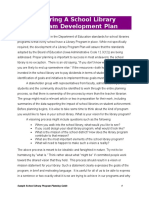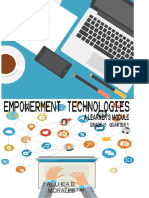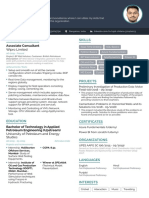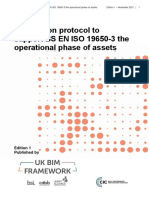Introduction To Digital Library
Introduction To Digital Library
Uploaded by
Suresh Chandra PandaCopyright:
Available Formats
Introduction To Digital Library
Introduction To Digital Library
Uploaded by
Suresh Chandra PandaOriginal Description:
Original Title
Copyright
Available Formats
Share this document
Did you find this document useful?
Is this content inappropriate?
Copyright:
Available Formats
Introduction To Digital Library
Introduction To Digital Library
Uploaded by
Suresh Chandra PandaCopyright:
Available Formats
INTRODUCTION Information and communication technology has revolutionized the concept of libraries.
each and every library is slowly getting digitized. A digital library(DL) compries digital collections, services and infrasturcture to support life long learning,research,sicholarly communication as well as preservation and conservation of our recorded knowledge. It is also a process of democratization of information. 1.WHAT IS DIGITAL LIBRARY? The concept of digital library is coming for digitalzation.The digitization is a process in which making and electronic version of a real worldobject or event, enabling the object to be stored displayed and mainpulatedona computer and disseminated over networks and the world wide web. Basically DL is nothing but a large database for the people who are working on hypertext enveroment. it is an environment which support the full life cycle of creation, storage, perservation, dissemination and use of data, information and knowledge. digital library is a combination of - A service. -An architecture. - A set of infor. resources, databases of text,graphics,sound, video. - A set of tools and capabilties to locate, retrieve and utilite the information resoureces available. According to Arms ''A DL is a managed collection of information of infor. with associarted services,where the infor. is stored in digital formated and accessible over a network. According to DLF( digital library federation) defien that DL are organizations that provide the resources, including the specilized sttaf, to select structure, offer intellectual access to interpret, distribute,preserve the integrity and ensure thepersistence overtime of collections of digital works so
that they are readily and economically available for use by a defined community or set of communities. Therefore the whole concept describe that DL is -A collection of documents in organized electronice form,available on the internet or on CD ROM disks,depending on the specific library, a user may be able to access magazine articles, books or other documents. - Organized collection of multimedia and other types of resources. - Resources are avaiable in computer processable form. - The function of acquistion, storage,preservation,retrierval is carried out through the use of digital technology. - Access to the entire collection is globally available directly or indirectly cross a network. - support users in dealing with information. 2. WHY WE NEED DL? Befor e we proceed, we know about the major factor or resons why we need the dl in our education system. Basically time is a major factor or each mordern user of the library for which the traditional library is known as digital library. The basice resions are _ Easy to understand. Shifting of the environment. Multiple fuction of same information. Information explosion. Information retival Growth of education. Growth of distance learning. To procure online publication. Develop the information technology. Searching problem in traditional library. Low cost of technology. New generation need.
3 .BENEFITS OF DL. The benefits of the DL incude the reduction in the physical storage of information less wear and tear on objectives. The ablity for several people to view the same item at the same time. The ablity to view the contents in the home,office or othen non library location and for increased cost-effectivenss. Amonge the possible costs are for digitalzation and to create metadata and retrival tools. It offers new levels of access to broader audiences of users and new opportunties for library and information science field to advice broth theory and practice. DL increase the portablity, efficiency of access, flexiblity, availability and presration of content DL can help move the nation towareds realizing the enormously powerful vesion of anytime,anywhere access to the best and latest of human thought and culture so that no ceass form knowledge resoures.
4.DIGITAL LIBRARY SOFTWARE The DL software is known as the open source s/w. Open sources s/w is a computer software for which the human readable source code is made available under a copyright licence. The proper definition of open sources s/w is a s/w which permits the users to use, change and improve the s/w and to redistribute it in modified or unmodified form. It is often developed in a public collaborated manner. The aim of open sources is to let product more understandable, modifiedable, duplicatable, reliable, simple accessible while it still marketable
There is much DL software available, proprietary as well as open source, and most of them conform to international standards. Some of the popular open sources softwares for DL are Dspace,Eprints, Greenstone and fedora etc i: Greenstone Digital Library Software (GSDL) It is produced by Newzland digital library project at the university of Waikat to and development and distributed incoporation with Unesco and Human information NGO. It is an open sources software distributed under the term of GNU public library linces. Greenstone provides a way of building, maintaining and distributing digital collections. opening up new possibilities for organizing information and making it available over the internet or cdrom. Greenstone is its commitment to lower the bar for construction of practical DL yet at the same time leave a great deal of facility in the hands of the users. ii. Eprints It is an open source software packages for building open access repository that provides with the open archive imitative protocol for metadata harvesting. Basically it is creates online archives. An Eprint archive can be adapted for many more purpose. Basically it is achieved a good platform in an academic institution. It has been developed at the university of Southampton in relation to a variety of project. The latest recommenended version is Eprints-2.3.11. in India NCSI has been conducting workshops and training programs for installing and customizing Eprints software.
iii. Dspace It is an open sources software package that provided the tools for managements of digital aspects and is commonly used as the basic for an institutional repository. Dspace is jointly developed by Hawlett Packard and MIT libraries collaborating over two years. Dspace provides the basic functionality equipment to operate an institutional digital repository and is intended to serve as a base for future development to address long term preservation and access issues.
5. PROCESS OF DIGITALIZATION. Digitalization is the central component of digital resources. Basically it is a process to shifting the traditional document to digitalized format. The process of digitalization is dealing 3 major components. Those are: 1-image creation 2-file management. 3-image delivery. 1.Image creation : Basically documents or information are available in two formats. That is born digital or e-document and creates digital. Born digital is already in a digitalized in time of publication. Those are not in digital form it is know as create digital. It deals with the initial capture on conversion of a document or object into digital form, typically with a scanner or digital camera broad classes of processing include image editing(scaling, compression, sharpening etc.) and metadata creation. 2.File management : It refers to organised, storage and maintain such images and relevant metadata.
3.Image delivery : It incorporates the process of getting to the users &includes networks, display devices &printers. It also incudes issues associated with creating delivering images. All those process is run successfully to the help of digital software. 6. DIGITAL LIBRARY ENVIROMENT. Just as the literature identifies a number of activities that together make up digital libraries, it also shows that the development of DL is having some factors . DL is successfully run to the support of: Own internet or intranet site. To support integrated access to resources. Digitalization of materials. Available E-publications. E-document delivery. Resource sharing. Cooperative end users.
7. PROCESS OF ESTALISHING DL IN EDUCATIONAL INSTITUTIONS.
A library is identified to be a Digital library when it renders information services required by the users in a digital form. Through some process the traditional library is shifted to a digital library. These process or activities are described below. Automation of entre library activities: The preliminary set up the digitalization process is automation or computerized the library. Through this process the work of
library and staff of library and also user are routine in a semi digital environment . On line public access catalogue(OPAC) : It is retrieval system in a very effective semi digital format. Under this system a particular resource may be searched with the title author publisher, call number, accession number etc. The function of opac is 1. Access to remote users. 2. Interlibrary loan is possible. 3. Access to resource throughout the world. 4. Knowledge sharing possible on all over the world. Internet connectivity(ic): Internet is basic element of DL. The internet of computer connected to each other for the purpose of sharing information. IC is like brain of DL.With out IC, DL can not work. Dissemination of resources through CD/DVD mirror server network technology : A library which moves digitalization should also utilise the technology of CD/DVD mirror server network. The whole concept is concerned mirror images of the contents of cd/dvd are crated and stored in the specialised Hardware & configurations using networking facilities. By using OPAC search engines facility required contents of CD/DVD can be accessed as per-priority of the users.
Online journals subscription: The DL should have access to online journals which are available free of cost. It is more useful to the users to browse the information from the online. It is very fast and very import to scholars.
Online database subscription: The databases will cover more no of web based publications like journals and magazines. And it provides the effective bringing subject wise publication in the web free of cost and free copyright problems. Procurement of E-books: The books are available in the web based languages. These books have the unique facility of multiple accesses. Any person form any part of the world at any time can access these resources with out facing any problem. Developing library information portal: The information portal is the entrance through which subscribed and free subscribed online journals and online databases and it can be stored under the name of digital library. Multimedia library services: It means providing library services using various digital technology. When the uses get these services he can feel more satisfied in addition to normal satisfaction level he attains while reading a traditional or printed books. In this services include semi-digitalisation services, subscriptions of online journals and databases, providing user education programme etc. Converting printed resources into digital resources During the process of conversion of printed copies into digital formats in order to develop the digital objects. It is possible through hadware (scanner, camera, CD/DVD, etc.) and software (any
suitable library software). It must take careful effort that the copyright act is not violated. Library web pages: In the process of digitalization itwould be more appropriate to develop a library web pages before starting subscription of digital resources and digital library.the library web page should be viable to access the web opac,all library resources and should collect all the ejournals, e-boooks,databases under the caption of the DL. It also add the information about the library, staff of library,all rules and regulation of library and new arrivals in book selection. Staff of library: The library work through a librarian. In creation of the digital library. It will be successful only when the librarian and staff or library supported by the management with reqired fund, positive approach etc. The staff of library should motivates the users to utilize the dL resources to its full extent. When the librarian and staff of library gets hundred percent utility form the side of the users, the digital library becomes successful. 8.CHALLENGES OF DIGITAL LIBRARY DEVELOPMENT IN INDIA. To creating a effective digital libraries process is a serius challenges. Because it will not be is a single, completely digital system that provides instant access to all information for all sectors of society,from any where in the world. Without any building, without any rules, and without problem. This is simple unrealistic. Some basic issues facing the development of DL are outlined below: Lack of prper information & communication technology infrastructure. Lack of proper planning &integration of information resoures. Barrio in proper copyright issues. Problem in flied of publication and publishers policies.
Lack of ICT polices. Problem in technical architecture. Lack of proffessionalisim in flied of library and information science. Lack of trained personnel in library. Barrier to information access and use. Lack of funding. Issue in preservation of digital information or materials. Lack of efficiency.
CONCLUSION The above disscution describe that digitalization is acomplex process requiring managerial and technical skills. But proper planning and management help in keeping the successful complication of a digital library.
You might also like
- Digital Library ProposalDocument7 pagesDigital Library ProposalSoftware Engineer100% (4)
- Pamantasan NG Lungsod NG MuntinlupaDocument4 pagesPamantasan NG Lungsod NG MuntinlupaSuper Rome100% (2)
- Changing Role of Librarians in Digital Library EraDocument7 pagesChanging Role of Librarians in Digital Library EraShivakumar TcNo ratings yet
- Digital LibraryDocument20 pagesDigital LibraryVinay Kainthola100% (2)
- Digital Libraries (Chap 1 & 2)Document23 pagesDigital Libraries (Chap 1 & 2)bobot91100% (2)
- Development and Characteristic of Digital Library As A Library BranchDocument6 pagesDevelopment and Characteristic of Digital Library As A Library Branchrohitmahali100% (1)
- The Pioneer of Reference ServicesDocument12 pagesThe Pioneer of Reference ServicesFlorabeth Graciella Bustamante Tanda100% (1)
- Resource Sharing and Modern LibraryDocument5 pagesResource Sharing and Modern LibrarySaurabh UpadhyayNo ratings yet
- Digital Library Development History and Its Role in Library Information Science: Mukesh C.bhartiDocument6 pagesDigital Library Development History and Its Role in Library Information Science: Mukesh C.bhartiMukesh C BhartiNo ratings yet
- Integrated Library Management System in Quezon City UniversityDocument6 pagesIntegrated Library Management System in Quezon City Universitykris jericho buenabilesNo ratings yet
- Digital Literacy - Definition Theoretical Framework and CompetenDocument7 pagesDigital Literacy - Definition Theoretical Framework and CompetennagasmsNo ratings yet
- Virtual Reference ServiceDocument14 pagesVirtual Reference ServiceRamo DženitaNo ratings yet
- Library Borrowing System Documentation: Chapter I - IntroductionDocument35 pagesLibrary Borrowing System Documentation: Chapter I - IntroductionÂñúräg SîñghNo ratings yet
- WXGB6311 Digital Libraries: Topic 1: IntroductionDocument12 pagesWXGB6311 Digital Libraries: Topic 1: IntroductionMary Ann SNo ratings yet
- Resource Sharing in LibraryDocument16 pagesResource Sharing in LibraryIreneNo ratings yet
- 2016 Library BudgetDocument20 pages2016 Library BudgetDarien LibraryNo ratings yet
- Impact of Technology in Library SystemsDocument28 pagesImpact of Technology in Library SystemsbryanNo ratings yet
- The Collection Development Planning ProcessDocument12 pagesThe Collection Development Planning ProcessKadian Chin100% (2)
- Collection Development PlanDocument6 pagesCollection Development Plankaatee_gNo ratings yet
- Philosophy, Services, Purpose, Nature and Challenges of Special LibrariesDocument9 pagesPhilosophy, Services, Purpose, Nature and Challenges of Special LibrariesAyotunde Badaru100% (2)
- Collection Development ProcessDocument57 pagesCollection Development ProcessCarlo NaveraNo ratings yet
- LIS 111 - Introduction To Records Mgt. and ArchivesDocument13 pagesLIS 111 - Introduction To Records Mgt. and ArchivesMitzi Portia VillanuevaNo ratings yet
- A Study of Additional Sources of Funding To Public Libraries in Katsina StateDocument62 pagesA Study of Additional Sources of Funding To Public Libraries in Katsina StateAhmad Deedat100% (1)
- Digitization Projects in Archives: Analyses and OutcomesDocument18 pagesDigitization Projects in Archives: Analyses and OutcomesHannah WilsonNo ratings yet
- Collection Development PlanDocument2 pagesCollection Development Planangel mae cuevas100% (2)
- Reference and Information Sources UnitDocument15 pagesReference and Information Sources UnitnagasmsNo ratings yet
- Lesson 7-Future of Reference and Information ServicesDocument12 pagesLesson 7-Future of Reference and Information ServicesGina May DaulNo ratings yet
- Differences Between Traditional & Digital LibrariesDocument2 pagesDifferences Between Traditional & Digital LibrariesNguyễn Kiều TrangNo ratings yet
- Questionnaire For Library UsersDocument2 pagesQuestionnaire For Library Userswaqif.khan100% (1)
- 7 Pages Exams Library Laws & PracticesDocument8 pages7 Pages Exams Library Laws & PracticesMichelle AbellaNo ratings yet
- Reference and Information Sources UnitDocument10 pagesReference and Information Sources Unitnagasms0% (1)
- A Study of The Students Use of Library For Developing Reading Culture in Secondary SchoolsDocument28 pagesA Study of The Students Use of Library For Developing Reading Culture in Secondary SchoolsNavya R NairNo ratings yet
- The Need For DigitizationDocument7 pagesThe Need For DigitizationMariza AgustinaNo ratings yet
- LLE Reviewer 2021Document257 pagesLLE Reviewer 2021Oliver Marundan EstimadoNo ratings yet
- Chapter12 Kimberly - Docx YTYFJ 1 (AutoRecovered)Document19 pagesChapter12 Kimberly - Docx YTYFJ 1 (AutoRecovered)Maejorie But-oyNo ratings yet
- Preparing School Lib PlanDocument7 pagesPreparing School Lib PlanKimberlyn CapinpinNo ratings yet
- Reflection To The Librarians CPDDocument2 pagesReflection To The Librarians CPDsarambalaNo ratings yet
- Collection Development Plan Template and GuideDocument11 pagesCollection Development Plan Template and GuideWhieslyn ColeNo ratings yet
- Chapter 1 - 5 BorrowDocument60 pagesChapter 1 - 5 BorrowumarsalehisahNo ratings yet
- Impact of Information Technology On Library Professional Working & Libraary Services by Mukesh BhartiDocument9 pagesImpact of Information Technology On Library Professional Working & Libraary Services by Mukesh BhartiMukesh C BhartiNo ratings yet
- 2013 Library BudgetDocument20 pages2013 Library BudgetDarien LibraryNo ratings yet
- Concept, Issues and Importance of Library Consortium: Problems and Prospects of University Library Consortium in BangladeshDocument23 pagesConcept, Issues and Importance of Library Consortium: Problems and Prospects of University Library Consortium in BangladeshMd. Anwarul Islam100% (1)
- Library & Information Science - 4th - Sem - Syllabus PDFDocument15 pagesLibrary & Information Science - 4th - Sem - Syllabus PDFLibrary & Information Science100% (1)
- ARANDA MALVAR PERALTA EBrgyRecord A Web Application Barangay Monitoring and Management SystemDocument68 pagesARANDA MALVAR PERALTA EBrgyRecord A Web Application Barangay Monitoring and Management SystemFrans Anacis GarciaNo ratings yet
- LIS ObjectiveDocument55 pagesLIS ObjectivePRASANTH KUMAR100% (2)
- Eport Reflection HeilmanDocument8 pagesEport Reflection Heilmanapi-653075991No ratings yet
- Archival Principles Respect Des Fonds and Principe de ProvenanceDocument2 pagesArchival Principles Respect Des Fonds and Principe de ProvenanceṦAi Dį100% (1)
- 40 Most Asked Librarian Interview Questions With AnswersDocument10 pages40 Most Asked Librarian Interview Questions With AnswersMuhammad Ali100% (1)
- Ict Implementation in Governance PDFDocument11 pagesIct Implementation in Governance PDFkomallotulkarNo ratings yet
- Current Trends in Information TechnologyDocument2 pagesCurrent Trends in Information Technologyvivek_sharma13No ratings yet
- Chapter 1 and 2 ThesisDocument30 pagesChapter 1 and 2 ThesisGenesis Sheldon LazoNo ratings yet
- Related LiteratureDocument8 pagesRelated LiteratureAJNo ratings yet
- FJHS Library Wolf Den Strategic Plan 2018-2021Document29 pagesFJHS Library Wolf Den Strategic Plan 2018-2021Jessica Humphrey100% (1)
- (Chapter 2 & 3) Online Book Inquiry and Reservation SystemDocument12 pages(Chapter 2 & 3) Online Book Inquiry and Reservation SystemLy Ann LoregaNo ratings yet
- Chapter 1 2 3 LATESTv - 2Document14 pagesChapter 1 2 3 LATESTv - 2Miguel Carl BasilioNo ratings yet
- SOPDocument2 pagesSOPDesiree MatienzoNo ratings yet
- Week 4 Conceptualization and Operationalization of Emerging TechnologiesDocument32 pagesWeek 4 Conceptualization and Operationalization of Emerging TechnologiesHeidi EmbatNo ratings yet
- Libraries As An Effective Instrument For Achieving Academic ExcelenceDocument37 pagesLibraries As An Effective Instrument For Achieving Academic ExcelenceGodfrey Moses100% (1)
- Digital Library Idlpt PDFDocument23 pagesDigital Library Idlpt PDFSandip DasNo ratings yet
- Digital Library Infrastructure and ArchitectureDocument8 pagesDigital Library Infrastructure and ArchitecturerohitmahaliNo ratings yet
- To Be Printed Emptech ModuleDocument67 pagesTo Be Printed Emptech ModuleAl Lhea Bandayanon MoralesNo ratings yet
- Nitro Pro 7 User GuideDocument156 pagesNitro Pro 7 User GuideShruti ChohanNo ratings yet
- Extensible Storage Engine (ESE) Database File (EDB) FormatDocument53 pagesExtensible Storage Engine (ESE) Database File (EDB) FormatKali LNo ratings yet
- Keystroke LotteriesDocument27 pagesKeystroke LotteriesBruce SwansonNo ratings yet
- MTC GRE ReviewDocument84 pagesMTC GRE ReviewTaffohouo Nwaffeu Yves ValdezNo ratings yet
- GiftcardMethod - 15.1 - EditionDocument7 pagesGiftcardMethod - 15.1 - EditionLtc MineNo ratings yet
- Allen-Bradley-Micrologix 1000 Programmable Controllers and Hand-Held ProgrammerDocument24 pagesAllen-Bradley-Micrologix 1000 Programmable Controllers and Hand-Held ProgrammerThe MatrixNo ratings yet
- ICSE 10 Sample Paper 1 AnsDocument14 pagesICSE 10 Sample Paper 1 Ansjosephmaryjudy78No ratings yet
- I22 0554 AliHashim Lab9Document1 pageI22 0554 AliHashim Lab9i220554 Syed MuhammadNo ratings yet
- Clase de RedaccionDocument34 pagesClase de RedaccionManuel Rodas VigoNo ratings yet
- Rajat Chilana - ResumeDocument1 pageRajat Chilana - ResumeRaviNo ratings yet
- 2018 IBM Systems Technical University: 22-26 Oct Rome, ItalyDocument28 pages2018 IBM Systems Technical University: 22-26 Oct Rome, ItalyAhmedNo ratings yet
- Project CommunicationsDocument5 pagesProject CommunicationsRazak AbuNo ratings yet
- V. QuadraticDocument17 pagesV. QuadratickankirajeshNo ratings yet
- Information Protocol Template To Support BS en ISO 19650 3Document21 pagesInformation Protocol Template To Support BS en ISO 19650 3ze100% (1)
- Imanager NetEco V600R010C10 APP User GuideDocument77 pagesImanager NetEco V600R010C10 APP User Guides mNo ratings yet
- Activity #7 - Network Definition, Types & UsesDocument4 pagesActivity #7 - Network Definition, Types & UsesmajorieNo ratings yet
- An5118 12 V 150 W Power Supply Based On stnrg011 Digital Combo and srk2001 Adaptive Synchronous Rectifier Controller StmicroelectronicsDocument74 pagesAn5118 12 V 150 W Power Supply Based On stnrg011 Digital Combo and srk2001 Adaptive Synchronous Rectifier Controller StmicroelectronicsJuan Carlos ColqueNo ratings yet
- Lecture 6 Application HolographyDocument26 pagesLecture 6 Application Holographyaishu3694No ratings yet
- Master Bizchannel Application FormDocument3 pagesMaster Bizchannel Application FormPaul SmithNo ratings yet
- Eaton Power DocumentDocument24 pagesEaton Power Documentsai siriNo ratings yet
- Capitol Tweets: New Edelman Study Looks at U.S. Congressional Performance On TwitterDocument23 pagesCapitol Tweets: New Edelman Study Looks at U.S. Congressional Performance On TwitterEdelmanNo ratings yet
- Embedded RISC MCU Family: SH-2/SH-DSPDocument6 pagesEmbedded RISC MCU Family: SH-2/SH-DSPsamsularief03No ratings yet
- I Voz Provider 2.XDocument150 pagesI Voz Provider 2.XNateNo ratings yet
- Ils VNS VNDDocument68 pagesIls VNS VNDCarlosNo ratings yet
- Three Key Requirements of Enterprise SD-WAN: Integrated Security, Multicloud Connectivity, and Application ReliabilityDocument7 pagesThree Key Requirements of Enterprise SD-WAN: Integrated Security, Multicloud Connectivity, and Application Reliabilitymasterlinh2008No ratings yet
- Intelligent+CIO+Africa+Issue+23 Avsharn BachooDocument100 pagesIntelligent+CIO+Africa+Issue+23 Avsharn BachooAnonymous m0Nh72lbNo ratings yet
- OC 210 UserManualDocument7 pagesOC 210 UserManualFrancisco GomezNo ratings yet
- Supercharge Your Data Science CareerDocument20 pagesSupercharge Your Data Science CareerRom100% (1)
- Web PentestDocument9 pagesWeb PentestsatheeshbabunNo ratings yet

























































































